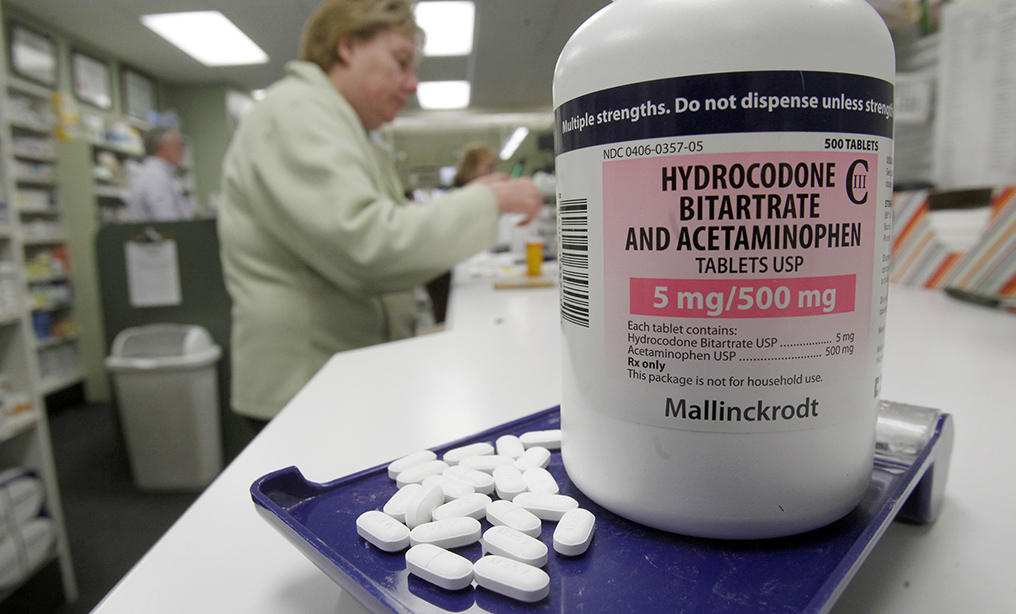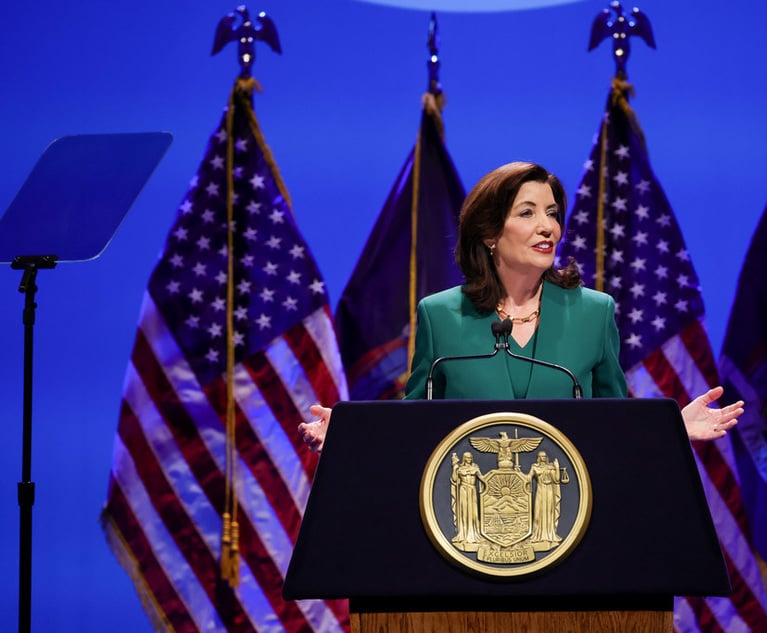Cuomo Revives Opioid Tax Struck Down by Federal Judge Last Year
The former opioid tax was struck down largely over a provision that barred companies from passing the cost of the surcharge onto their customers.
February 15, 2019 at 04:32 PM
5 minute read
 Opioid tax would be paid quarterly by opioid companies rather than a surcharge paid annually as it was in the previous law. Photo: Toby Talbot/AP
Opioid tax would be paid quarterly by opioid companies rather than a surcharge paid annually as it was in the previous law. Photo: Toby Talbot/AP
Gov. Andrew Cuomo is asking state lawmakers to revive a tax on the sale of opioids in New York in an effort to curb drug overdoses after a similar law was struck down by a federal judge as unconstitutional late last year.
But unlike the now-defunct Opioid Stewardship Act, the cost of that tax on opioid companies would be allowed to be passed on to consumers who are prescribed those drugs, according to the legislation, which has the potential to raise prices.
The first attempt at imposing an opioid tax by state law was struck down largely over a provision that barred companies from passing the cost of the surcharge onto their customers. U.S. District Judge Katherine Polk Failla of the Southern District of New York wrote in a decision in December that the so-called pass-through provision of the law violated the dormant commerce clause of the U.S. Constitution.
“New York's position is seriously, if not mortally, wounded by the fact that the text of the OSA places no such limitation on the pass-through prohibition,” Failla wrote. “If OSA's provisions are given their clearest meaning, the dormant commerce clause violation is clear.”
The law may have forced companies to, instead, impose the cost of New York's opioid tax on consumers in other states, Failla wrote. The new proposal would avoid that conflict by allowing the expense to be passed on to consumers regardless of their location.
“The economic incidence of the tax imposed by this article may be passed to a purchaser,” the legislation reads.
The new proposal would also change how and when the tax is collected, two provisions that were challenged in the lawsuit last year. The litigation was brought by the Healthcare Distribution Alliance, an organization representing pharmaceutical distributors.
A spokesman for the organization said they were reviewing the new proposal and declined to initially comment on it.
They took issue with how the state planned to collect the surcharge in the previous law. The state had planned to require opioid manufacturers and distributors to collectively pay $100 million to the state over six years. The amount each company was expected to pay would have been determined based on the share of business they report in New York.
Opioid companies challenged that part of the law because they said it took the amount they would pay out of their hands, and put it at risk of another company's choices.
The state is still expected to generate $100 million from the tax, but it would be collected differently. It would be set like a sales tax paid quarterly by opioid companies rather than a surcharge paid annually as it was in the previous law.
If the manufacturer's list price to wholesalers or direct purchasers for an opioid unit is less than 50 cents, they would pay a quarter of a cent per morphine milligram equivalent, or the strength of the drug compared to morphine as determined by the state Department of Health. If the list price is more than 50 cents, that company would pay 1.5 cents per morphine milligram equivalent.
The first round of taxes paid by each company would be based on the amount they sell between when the legislation is signed and Jan. 20, 2020. After that, the tax would be paid by companies each quarter based on reports filed with the state.
That method is also different from the previous version, which would have had companies make their initial payment to the state based on sales from before the law was passed. HDA had argued against that provision of the statute in their lawsuit, saying it was unlawful for the state to impose such a charge on retroactive sales.
The reports sent to the state on those sales would not be made public, according to the legislation. If a state employee makes them public or divulges any information from them without a court order, the legislation would allow them to be fired.
Cuomo included the new proposal in his 30-day budget amendments, which are released a month after the governor presents his executive budget proposal to the Legislature each year. Lawmakers were supportive of the proposal last year.
The state budget is due by the end of March.
READ MORE:
NY Opioid Surcharge Law Struck Down by Federal Judge as Unconstitutional
NY State Urges Opioid Distributors' Challenge to Surcharge Be Moved Out of Federal Court
Opioid Distributors Sue NY State Over Surcharge They Call 'Unconstitutional'
This content has been archived. It is available through our partners, LexisNexis® and Bloomberg Law.
To view this content, please continue to their sites.
Not a Lexis Subscriber?
Subscribe Now
Not a Bloomberg Law Subscriber?
Subscribe Now
NOT FOR REPRINT
© 2025 ALM Global, LLC, All Rights Reserved. Request academic re-use from www.copyright.com. All other uses, submit a request to [email protected]. For more information visit Asset & Logo Licensing.
You Might Like
View All
Bipartisan Lawmakers to Hochul Urge Greater Student Loan Forgiveness for Public-Interest Lawyers

'Playing the Clock'?: Hochul Says NY's Discovery Loophole Is to Blame for Wide Dismissal of Criminal Cases

So Who Won? Congestion Pricing Ruling Leaves Both Sides Claiming Victory, Attorneys Seeking Clarification
4 minute read
Hochul Vetoes 'Grieving Families' Bill, Faulting a Lack of Changes to Suit Her Concerns
Trending Stories
- 1Democracy in Focus: New York State Court of Appeals Year in Review
- 2In Vape Case, A Debate Over Forum Shopping
- 3SDNY Criminal Division Deputy Chief Returns to Debevoise
- 4Brownstein Adds Former Interior Secretary, Offering 'Strategic Counsel' During New Trump Term
- 5Tragedy on I-95: Florida Lawsuit Against Horizon Freight System Could Set New Precedent in Crash Cases
Who Got The Work
J. Brugh Lower of Gibbons has entered an appearance for industrial equipment supplier Devco Corporation in a pending trademark infringement lawsuit. The suit, accusing the defendant of selling knock-off Graco products, was filed Dec. 18 in New Jersey District Court by Rivkin Radler on behalf of Graco Inc. and Graco Minnesota. The case, assigned to U.S. District Judge Zahid N. Quraishi, is 3:24-cv-11294, Graco Inc. et al v. Devco Corporation.
Who Got The Work
Rebecca Maller-Stein and Kent A. Yalowitz of Arnold & Porter Kaye Scholer have entered their appearances for Hanaco Venture Capital and its executives, Lior Prosor and David Frankel, in a pending securities lawsuit. The action, filed on Dec. 24 in New York Southern District Court by Zell, Aron & Co. on behalf of Goldeneye Advisors, accuses the defendants of negligently and fraudulently managing the plaintiff's $1 million investment. The case, assigned to U.S. District Judge Vernon S. Broderick, is 1:24-cv-09918, Goldeneye Advisors, LLC v. Hanaco Venture Capital, Ltd. et al.
Who Got The Work
Attorneys from A&O Shearman has stepped in as defense counsel for Toronto-Dominion Bank and other defendants in a pending securities class action. The suit, filed Dec. 11 in New York Southern District Court by Bleichmar Fonti & Auld, accuses the defendants of concealing the bank's 'pervasive' deficiencies in regards to its compliance with the Bank Secrecy Act and the quality of its anti-money laundering controls. The case, assigned to U.S. District Judge Arun Subramanian, is 1:24-cv-09445, Gonzalez v. The Toronto-Dominion Bank et al.
Who Got The Work
Crown Castle International, a Pennsylvania company providing shared communications infrastructure, has turned to Luke D. Wolf of Gordon Rees Scully Mansukhani to fend off a pending breach-of-contract lawsuit. The court action, filed Nov. 25 in Michigan Eastern District Court by Hooper Hathaway PC on behalf of The Town Residences LLC, accuses Crown Castle of failing to transfer approximately $30,000 in utility payments from T-Mobile in breach of a roof-top lease and assignment agreement. The case, assigned to U.S. District Judge Susan K. Declercq, is 2:24-cv-13131, The Town Residences LLC v. T-Mobile US, Inc. et al.
Who Got The Work
Wilfred P. Coronato and Daniel M. Schwartz of McCarter & English have stepped in as defense counsel to Electrolux Home Products Inc. in a pending product liability lawsuit. The court action, filed Nov. 26 in New York Eastern District Court by Poulos Lopiccolo PC and Nagel Rice LLP on behalf of David Stern, alleges that the defendant's refrigerators’ drawers and shelving repeatedly break and fall apart within months after purchase. The case, assigned to U.S. District Judge Joan M. Azrack, is 2:24-cv-08204, Stern v. Electrolux Home Products, Inc.
Featured Firms
Law Offices of Gary Martin Hays & Associates, P.C.
(470) 294-1674
Law Offices of Mark E. Salomone
(857) 444-6468
Smith & Hassler
(713) 739-1250






